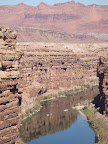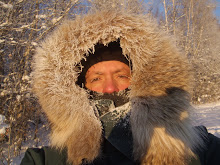Rigging Day -- Flagstaff to Lee's Ferry
The "Reynolds" trip crew woke early, and were treated to a great breakfast of "Egg McMichael" sandwiches while packing and repacking our dry bags and organizing our gear which was collecting in what seemed like an impossibly large pile outside of the River House. How would all this stuff fit in four rafts? Marilyn picked the 15 of us up in the Moenkopimobile and drove us to Lee's Ferry, We tried to keep everyone on the bus so that we didn't have to count and recount to make sure that we weren't leaving anyone behind. It was a hot trip, filled with anticipation for getting on the river.
For me, the geologic field trip had already started the day before on the Arizona Shuttle ride from Phoenix where we went up and over the Mogollon Rim and up on to the Colorado Plateau. The field trip continued on the outskirts of Flagstaff where we could clearly see the forested volcanic landforms of the geologically young San Fransisco Volcanic Field. As we neared the Little Colorado we could look to the west and see the Moenkopi Escarpment, a monocline (single sided fold or step in otherwise horizontal rocks).
After crossing the Little

Colorado, which was bank full and running muddy from the recent rains we could see the Echo Cliffs to the east, which are capped by the Navajo Sandstone the youngest layered rocks that we will see on this trip until we float the length of the canyon and pass the Grand Wash Cliffs. The Echo cliffs mirror the Vermillion Cliffs on the North side of the Colorado River and dominate the panoramic view in the area of the Navajo Bridge and Lee's Ferry.
Upon arrival at the Lee's ferry rigging site we disembarked into a scene of chaos and confusion as Moenkopi Riverworks was trying to launch another group as well as ours, our boats were partially rigged, but there was still much to load and rig. Rico, Marilyn and the rest of the Moenkopi crew did an amazing job of answering questions, giving advice, and dividing up the gear between the 32 trip participants and the flat-bed truck of gear and boats. I ended up with the 18-foot Avon, which would become my home and steed for the next three weeks I have a soft place in my heart for her still.
As a boatman, I soon learned that one of my responsibilities was to know what was loaded on the Avon and where it was stowed,. Although it changed a little from day to day this is what the Avon and I carried for the next three weeks:
- Bow frame hatch: camp stove, 20 lb propane bottle, expedition water filter, two rocket boxes of food (days 7-8) . The boxes of food were converted to rocket boxes of garbage and recyclables as the food was consumed, so by the 8th day my poor Avon had become the garbage scow.
- Ice chest: ( the seat for the rower) 4 yellow squash, a dozen or so zucchini, several heads each of romaine and iceberg lettuce, some spring mix greens, 4 bunches of celery, dozens of tomatoes and avocados, and a block of ice large enough that there was still some left 20 days later.
- Bread Box: (aluminum dry box at the left side of the rower's feet) 4 loaves multigrain bread, 12 packages pita bread, 6 loaves french bread, 2 boxes of Kashi cereal, 2 packages of nut clusters, 3 dozen bagels, 3 dozen english muffins...maybe more.
- Pot box: (aluminum dry box at the right side of the rowers feet) 18 plates, 18 bowls, 18 tumblers, several large mixing bowls, three large stock pots, some fry pans.
- Stern frame hatch: (forms the bench seat for the raft passengers) Rocket boxes for days 1-6.
- Under the bow gear net: several cases of canned soda, three large personal dry bags, an outfitter wing tarp, two folding beach chairs.
- Lashed down on top of the bow hatch, one large personal dry bag, a large dry bage with half of the tents, a wing, a couple day dry bags, four of the infamous Paco pads, a spare PFD.
- Lashed down on the side decks: ammo boxes that contain first aid kit, a boat repair kit, and 4 separate personal kits. A Pelican case with a s phone, and a net bag with extra straps, spare oar towers, a sand stake, a rubber mallet and a PVC pipe for the boat umbrella.
- Lashed down on the stern frame hatch: a large aluminum kitchen table with slots so that it could double as a long spine board and a really sad water logged paco pad.
- In a drop bag in the stern: three to four folding soccer mom chairs, some treking poles and occasionally a folding cot.
- Lashed down elsewhere: two five gallon water jugs, two 5 gallon buckets ( mine were used as urinals in camp how lucky is that!), a large beach umbrella (that liked to launch in a gusts), various personal water bottles, and a waterproof map case that I kept on top of the pot box so that I could navigate as we floated down the river.
- Also lashed down around the boat were as many as two kayaks, the deflated inflatable kayak (duckie) and inflatable canoe (Grabner), and a bundle of spare paddles.
- Lashed each side were spare oars, they were kept easy to access.
If all this stuff were in a pile on the beach, it would be hard to believe that it all fit in the raft. Except for the bread box, ice chest, repair kit, strap bag, and oars all of the stuff gets unloaded every night and reloaded every morning. It's all part of the rhythm of the river.
After moving 100 yards down the river to the boaters camp ( I forgot and left my PFD at the rigging beach, then sheepishly recovered it) that was the
last time that I would do that on the trip. Then we had dinner and a second pre-trip group meeting at the Marble Canyon Lodge.
I slept on the boat that night after reading some John Wesley Powell under a nearly full moon. I was restless with the anticipation for what was to come in the following days...
